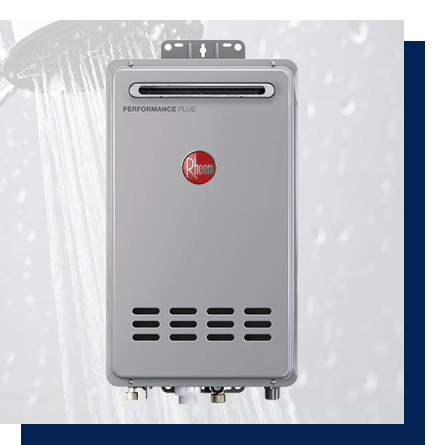
A tankless water heater is a wise option for those who want to reduce their energy costs. In addition, it offers you an endless supply of hot water as long as the gas or electricity keeps running, and there’s no need to wait around for the water to warm up!
Tankless Water Heater Versus Storage Tank Water Heater
The tankless water heater is very different from the typical storage-type water heater in most people’s homes. You can explain the most significant difference between these two by looking at how they function. As the name suggests, a tankless water heater has no tank and no storage capacity. This is because it draws on either gas or electricity to heat your water when you want it. Cold water enters through a pipe and is heated with an electric coil or gas burner before running out of the faucet hot and ready for use.
How Does a Tankless Water Heater Work?
There are various components in a tankless water heater. If you were to open one up, you’d find a heat exchanger, a flow sensor and an electronic controller.
The heat exchanger is filled with many small copper tubes. When the heat source is engaged, these are heated. Cold water flows in through one end of the heat exchanger and passes through the copper tubes. Whether your tankless model uses electricity or natural gas to heat water, the liquid’s temperature will reach approximately 150 degrees Fahrenheit. Once it does, it’s ready to flow out of your faucet.
The flow sensor checks to see if there’s enough water moving through the pipes. Consequently, there’s no need to wait until an entire tank has been heated before you have hot water available. When you’re done with your hot water usage, the system will register that. The heater will turn off, and the heat exchanger will cool down.
Types of Tankless Water Heaters
You’ll find two basic kinds of these devices. There is an on-demand tankless system and a continuous-flow type. The on-demand models only produce hot water only when a shower or a faucet is running. These units can be placed either indoors or outdoors, so they can be used for outdoor kitchens and home spas. Continuous-flow models produce hot water on a constant basis regardless of whether a valve or faucet is open.
Benefits of Using a Tankless Water Heater
Rather than storing hot water for eventual use, a tankless unit produces hot water on demand. Creating it when needed saves both energy and money because the energy expended to sustain the temperature of a large volume of water in a tank isn’t wasted.
Tankless water heaters can provide an endless supply of hot water. This makes them ideal for many commercial venues. The efficiency and the reduced utility bills help a company’s bottom line.
If a home has limited space for water storage, a tankless water heater would be suitable. When space is at a premium, you should consider this alternative.
The prospect of unlimited hot water is very attractive. Since a tankless heater only warms cold water when hot water is required, it uses less power to produce a better outcome. Feel free to use as much hot water as you please without the worry of running out.
Unlike a traditional storage water heater, a tankless device will furnish hot water at a set temperature and ensure a constant supply of it. Some models have a recovery rate as high as 95%. That means you shouldn’t run out of hot water.
Tankless water heaters are also quieter than standard models. A traditional tank storage water heater needs to operate constantly, but the tankless type doesn’t. Consequently, it’s better able to quickly recover from surges in demand, and it doesn’t make noise when not in use.
For scenarios where the available space is limited, the space-saving tankless water heater design is ideal. You can fit one into a small compartment or other compact area. This means one can be installed in almost any home.
Disadvantages of Tankless Water Heaters
Since the installation requires more effort, there is a higher initial cost. Although tankless systems can represent a more expensive initial investment than a traditional tank storage system, much of this will be recouped over time through lower operating costs.
The fact that tankless systems don’t store hot water means the only way to obtain it is by producing it. This might pose problems in places that are known for particularly cold weather or for households with lots of people who insist on hot showers at the same time.
Sediment build-up is another common issue with tankless water heaters. This occurs when minerals in the water accumulate inside the pipes and the heating chamber. The result can be a significant drop in water pressure. Furthermore, the water might be cloudy or discolored. Flushing out the system by running lots of hot water through it is worth a try, but you may require the assistance of a professional plumber to remedy this situation. If you’re located in or around San Antonio, our experts at Beyer Plumbing can take care of it for you.
Some tall buildings have problems with tankless water heaters. That’s because a tankless system works by constantly extracting electricity in small amounts, even when hot water is not in use. This is required to keep the element hot, and a tankless unit can demand up to two times as much electricity as a standard system. Due to this, it also needs specialized electrical wiring, which might or might not be available in a commercial building.
Tankless Water Heater Maintenance Requirements
There is an air filter in a tankless water heater that should be cleaned periodically, approximately every year or two. The process is straightforward, and you can do it yourself. Once the unit is opened, the filter can be removed and cleaned with vinegar or warm soapy water.
You should also periodically flush the system on a tankless water heater. There’s a fundamental reason why this is important. It prevents deposits of sediment and calcium from building up. It’s a necessary process, and the simple chore will help keep your device running smoothly. Most plumbing companies and manufacturers recommend performing this maintenance at least once a year.
Before doing it, however, there is an essential step that can’t be overlooked. Turn off the valves attached to the water heater. This involves both the gas valve and the valve for the cold-water supply. If you have an electric model, switch off the circuit breaker rather than the gas. This precaution ensures that no harm comes to either you or the equipment you’re working on. Otherwise, you might possibly cause equipment damage or start a fire.
Your local Resource for Tankless Water Heaters
If you’re interested in purchasing a tankless water heater or you have one that requires professional attention, turn to our team at Beyer Plumbing. We’ve been providing the people of the San Antonio region with expert plumbing services since 1990. Besides pipe repair and replacement, drain cleaning and leak detection, we handle water softener and water quality systems and much more. Yes, that includes water heaters. If you want to speak with our experts about tankless water heaters or any other plumbing concerns, call us today.


